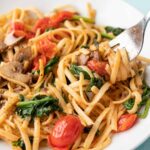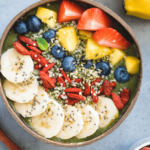Embark on a culinary journey into the vibrant world of flexitarian baking! Imagine sinking your teeth into deliciously moist muffins bursting with vibrant fruits and subtly sweet vegetables, or savoring the satisfying crumb of a hearty loaf, packed with wholesome grains and savory herbs. This isn’t just about healthy eating; it’s about unlocking a world of flavor and creativity in the kitchen, where mindful choices meet mouthwatering results. Discover how to effortlessly incorporate the principles of flexitarian eating into your baking, transforming familiar recipes into nutritious and exciting masterpieces.
This guide delves into the art of flexitarian baking, providing a comprehensive exploration of healthy flour alternatives, insightful recipe development for both sweet and savory delights, and expert tips to ensure your baking triumphs. From understanding the nutritional profiles of various flours to mastering the techniques for achieving optimal texture and flavor, we’ll equip you with the knowledge and confidence to create stunning flexitarian baked goods that will impress even the most discerning palates. Prepare to expand your baking horizons and redefine what “healthy” can truly taste like.
Recipe Development
Developing delicious and healthy flexitarian sweet treats requires a mindful approach to ingredient selection and baking techniques. By incorporating whole grains, fruits, and vegetables, we can create desserts that are both satisfying and nutritious, appealing to a wide range of dietary preferences. The recipes below showcase the versatility of flexitarian baking, offering unique flavor profiles and textures.
Three Unique Flexitarian Sweet Treat Recipes
The following recipes provide step-by-step instructions for creating three distinct flexitarian desserts: Carrot Cake Muffins, Oatmeal Cranberry Cookies, and Apple Beetroot Cake. Each recipe prioritizes whole grains, fruits, and vegetables for a wholesome and flavorful experience.
| Recipe | Ingredients | Instructions | Nutritional Information (per serving, approximate) | |||||||||||||||||||||||
|---|---|---|---|---|---|---|---|---|---|---|---|---|---|---|---|---|---|---|---|---|---|---|---|---|---|---|
| Carrot Cake Muffins |
|
|
|
|||||||||||||||||||||||
| Oatmeal Cranberry Cookies |
|
|
|
|||||||||||||||||||||||
| Apple Beetroot Cake |
|
|
|
Tips and Tricks for Optimal Texture and Flavor
Achieving the perfect texture and flavor in flexitarian baking requires attention to detail. Using high-quality ingredients is crucial, and understanding the role of each component ensures success. For example, in the Carrot Cake Muffins, the applesauce adds moisture and binds the ingredients, while the nuts provide texture and richness. In the Oatmeal Cranberry Cookies, the oats provide a chewy texture, and the cranberries offer a burst of tartness. The Apple Beetroot Cake benefits from the earthy sweetness of the beetroot, which complements the apple’s tartness.
To ensure optimal results, avoid overmixing the batter in all recipes. Overmixing develops gluten, leading to a tough texture. Also, ensure your baking powder and soda are fresh for proper leavening. Finally, allow the baked goods to cool completely before serving to allow the flavors to fully develop and the textures to set.
Recipe Development
Savory baking offers a delightful and versatile alternative to its sweeter counterpart, allowing for creative exploration of textures and flavors. The following recipes showcase the potential of legumes, vegetables, and herbs in creating wholesome and satisfying flexitarian baked goods, catering to different skill levels. Each recipe emphasizes clear instructions and readily available ingredients.
Savory Baking Challenges and Solutions
Baking with savory ingredients presents unique challenges compared to sweet baking. The lack of inherent sweetness means relying on other elements to create balanced flavors. Vegetables, for instance, can release excess moisture, leading to soggy baked goods. Legumes, while adding protein and texture, can also impact the final product’s consistency if not handled correctly. Careful ingredient selection and precise techniques are key to overcoming these hurdles. Solutions often involve techniques such as pre-cooking vegetables to remove excess moisture, using well-drained legumes, and incorporating binding agents like eggs or flaxseed meal to improve structure. Flavor balancing is crucial; acidic elements like lemon juice or vinegar can counteract any potential earthiness from vegetables or legumes. Experimentation and understanding the properties of each ingredient are paramount to successful savory baking.
Beginner: Cheesy Three-Bean and Cheddar Muffins
These muffins are simple to make and deliver a hearty, satisfying snack or light meal. The combination of three beans provides a rich texture, while cheddar cheese adds a savory sharpness.
- Ingredients: 1 cup canned cannellini beans (drained and rinsed), 1/2 cup canned kidney beans (drained and rinsed), 1/2 cup canned black beans (drained and rinsed), 1 cup all-purpose flour, 1 teaspoon baking powder, 1/2 teaspoon baking soda, 1/4 teaspoon salt, 1/4 cup grated cheddar cheese, 1/4 cup milk, 1 large egg, 2 tablespoons olive oil.
- Instructions: Preheat oven to 400°F (200°C). Grease a 12-cup muffin tin. In a large bowl, mash beans coarsely with a fork. Add flour, baking powder, baking soda, and salt; mix well. Stir in cheese, milk, egg, and olive oil until just combined. Fill muffin cups about 2/3 full. Bake for 18-20 minutes, or until a toothpick inserted into the center comes out clean. Let cool in the tin for a few minutes before transferring to a wire rack to cool completely.
Intermediate: Roasted Vegetable and Rosemary Scones
These scones offer a sophisticated savory experience. The roasting process intensifies the vegetables’ flavors, while rosemary provides an aromatic touch.
- Ingredients: 1 cup all-purpose flour, 1 teaspoon baking powder, 1/2 teaspoon salt, 1/4 cup cold unsalted butter (cut into cubes), 1/2 cup roasted vegetables (such as bell peppers, zucchini, and onions, chopped), 1 tablespoon chopped fresh rosemary, 1/2 cup milk.
- Instructions: Preheat oven to 425°F (220°C). Combine flour, baking powder, and salt in a large bowl. Cut in butter using a pastry blender or your fingers until the mixture resembles coarse crumbs. Stir in roasted vegetables and rosemary. Gradually add milk, mixing until just combined. Turn dough out onto a lightly floured surface and pat into a 1-inch thick circle. Cut into 8 wedges. Bake for 15-18 minutes, or until golden brown. Serve warm.
Advanced: Lentil and Walnut Loaf with Caramelized Onions
This loaf requires more steps but results in a complex and flavorful bread perfect for a sophisticated meal. The caramelized onions add a touch of sweetness that balances the earthiness of the lentils and walnuts.
- Ingredients: 1 cup brown or green lentils (cooked), 1/2 cup walnuts (chopped), 1 cup all-purpose flour, 1/2 cup whole wheat flour, 1 teaspoon baking powder, 1/2 teaspoon baking soda, 1/2 teaspoon salt, 1 cup caramelized onions, 1 cup vegetable broth, 1/4 cup olive oil, 1 large egg.
- Instructions: Preheat oven to 350°F (175°C). Grease and flour a 9×5 inch loaf pan. In a large bowl, combine cooked lentils, walnuts, flours, baking powder, baking soda, and salt. In a separate bowl, whisk together caramelized onions, vegetable broth, olive oil, and egg. Add wet ingredients to dry ingredients and mix until just combined. Pour batter into prepared loaf pan and bake for 50-60 minutes, or until a toothpick inserted into the center comes out clean. Let cool in the pan for 10 minutes before transferring to a wire rack to cool completely.
Tips and Techniques for Success

Mastering the art of flexitarian baking requires a blend of understanding and skillful execution. This section delves into essential tips and techniques to elevate your flexitarian baking journey, ensuring consistently delicious and healthy results. From ingredient substitutions to troubleshooting common baking pitfalls, we’ll equip you with the knowledge to confidently create exceptional flexitarian baked goods.
Ingredient Substitutions for Flexitarian Baking
Successful flexitarian baking hinges on smart ingredient substitutions. Replacing traditional ingredients with healthier alternatives often requires careful consideration of texture and flavor. For example, substituting applesauce for oil in muffins reduces fat content while maintaining moisture; the applesauce adds a subtle sweetness and helps bind the ingredients. Similarly, replacing refined sugar with maple syrup or mashed banana introduces natural sweetness and adds moisture. Ground flaxseed meal mixed with water can act as an egg replacement, binding ingredients and adding a slightly nutty flavor. Experimentation is key; understanding the role each ingredient plays allows for effective substitutions.
Precise Measuring Techniques for Consistent Results
Accurate measuring is paramount in baking, even more so when working with healthier, often less predictable ingredients. Using a kitchen scale for dry ingredients like flour and whole grains ensures consistency, as volume measurements can vary significantly depending on how the ingredient is packed. For liquids, use a liquid measuring cup, filling it to the designated line at eye level. These precise measurements are crucial for achieving the desired texture and rise in your baked goods. Inconsistent measurements can lead to dense, dry, or gummy results.
Troubleshooting Common Baking Problems
Even experienced bakers encounter challenges. A common issue is a dense loaf of bread, often caused by overmixing the dough, which develops too much gluten, resulting in a tough texture. Conversely, undermixing can lead to a crumbly loaf. Another common problem is muffins that crumble easily, often due to insufficient liquid or overbaking. Overbaking results in dry, hard baked goods. Paying close attention to baking times and using a toothpick to check for doneness is crucial. A slightly moist crumb is generally desirable.
Adapting Existing Recipes for Flexitarian Baking
Transforming traditional recipes into flexitarian-friendly versions is achievable with a few strategic adjustments. Start by identifying areas where healthier swaps can be made. For example, a cake recipe can be modified by reducing the amount of butter and sugar, replacing some of the flour with whole wheat flour, and incorporating fruits or vegetables for added nutrients and moisture. Remember to adjust baking times as needed, as healthier ingredients may require slightly longer baking times to achieve the same level of doneness.
Visual Descriptions of Ideal Textures and Appearances
Visual cues are invaluable in flexitarian baking. A healthy loaf of bread should boast a beautifully even crumb structure, with a light and airy texture, rather than dense and compact. The crumb should have a slightly irregular pattern, indicating good gluten development. A perfectly moist muffin will have a tender crumb, neither dry nor gummy. Its surface should have a slightly domed top, with a soft and appealing texture. The color should be consistent, reflecting the ingredients used. A vibrant, evenly browned surface suggests proper baking. A cake should exhibit a fine, even crumb structure with a moist, but not soggy, texture. Its surface should be smooth and evenly browned.
As you conclude your journey through this ultimate guide, remember that flexitarian baking is not just about restriction, but about boundless exploration. It’s about embracing the vibrant colors and flavors of nature, skillfully weaving them into delectable creations that nourish both body and soul. The recipes, tips, and techniques shared within these pages are designed to empower you, inspiring confidence in your ability to craft healthy, delicious baked goods that you’ll proudly share with loved ones. So, gather your ingredients, preheat your oven, and unleash your inner flexitarian baker – the possibilities are as endless as your imagination.
Essential FAQs
Can I use substitutes for the suggested ingredients?
Yes, many substitutions are possible. The guide provides suggestions and guidance on adapting recipes to your preferences and dietary needs.
How long do the baked goods typically last?
Storage varies depending on the recipe. Generally, store baked goods in airtight containers at room temperature for a few days or in the refrigerator for longer storage.
Are these recipes suitable for beginners?
Yes, the guide includes recipes for all skill levels, from beginner to advanced, with clear instructions and helpful tips.
What are the key benefits of flexitarian baking?
Benefits include increased nutritional value, reduced reliance on processed ingredients, exploration of diverse flavors and textures, and a more sustainable approach to baking.


